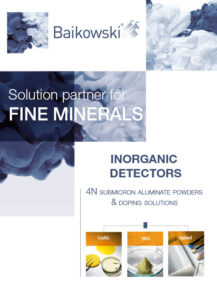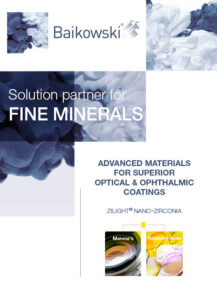Advanced HPA, YAG, Spinel, and Nano-zirconia solutions for Optics and Photonics
Optics and photonics deal with light and its properties. However optics focuses on light behaviour, such as rays and waves, whereas photonics emphasizes the quantum nature of light, such as photons and lasers. In order to provide solutions that offer outstanding characteristics for both, optics and photonics markets, our R&D teams develop products with controlled size distribution, high crystallinity, phasic and chemical purity.
View optics and photonics related products
Baikowski® High Purity Alumina, spinel and YAG solutions for optics and photonics materials

Thanks to their refractive index, transparency, hardness, and chemical stability, Baikowski®’s submicron aluminate powders are suitable for various optical components production:
- 🌟 High purity alumina, known for its excellent mechanical and thermal stability, is extensively used in optical windows, infrared lenses, high-power laser systems…..
- 🌟 Spinel, renowned for its optical transparency, durability, and resistance to harsh environments, is utilized for example in optical domes and laser gain media.
- 🌟 YAG and LuAG,these phosphors exhibit exceptional luminescent properties and can convert light of one wavelength into light of another wavelength. They are employed in lighting technologies and displays, including LED lighting and optoelectronic devices.They drive innovation in the optics and photonics market, enabling advancements in fields like telecommunications, biomedical imaging, military technology, and more.
Download our Inorganic Detectors White Paper
Mathym® nano-zirconia and ceria potential for optics and photonics applications
Mathym® Research and Development efforts are uncovering new avenues to exploit nano-oxides such as their commercial nano-zirconia solutions, but also nano-ceria as R&D products, that are already shaping the future of optical technologies :
- 🌟 Nano-zirconia has good transparency across a wide range of wavelengths, including the visible and near-infrared regions. Its high refractive index make it valuable for the production of lenses and optical fibers. zilight® from Mathym® is as small as 5nm and meets high-end optical applications where small particle size is key.
- 🌟 Nano-ceria exhibits good transparency in the UV and visible range, making it suitable for optical components such as lenses, windows, and filters from optical surfaces. It can act as an effective catalyst, which can be advantageous in certain photonics and optoelectronic applications. Mathym® nano-ceria is available as R&D samples and exhibits Key charaterisitcs for these applications such as high crystallinity, low organic content and narrow size distribution.
 From refractive index adjustment between optical films to the design of transparent materials pushing the upper limits of refractive index, these advanced products will play a significant role in the optical industry. Anti-reflection coatings, display applications such as microLED, AR / VR / MR, OLED and LED lighting, optical components such as telescope lenses, and optical sensors are some of the technologies that can benefit from their superior optical performance and ease of processing.
From refractive index adjustment between optical films to the design of transparent materials pushing the upper limits of refractive index, these advanced products will play a significant role in the optical industry. Anti-reflection coatings, display applications such as microLED, AR / VR / MR, OLED and LED lighting, optical components such as telescope lenses, and optical sensors are some of the technologies that can benefit from their superior optical performance and ease of processing.
Mathym® nanodispersions are compatible with various manufacturing processes including dip and spin coating, nanoimprint lithography, inkjet printing and screen printing. They are engineered to be incorporated in the formulations of coatings, inks, adhesives, and molding compounds.
When nanoparticles are integrated into nanoscale structures or coatings, they enable the miniaturization of optical devices and integration with other technologies. This can facilitate the development of compact and multifunctional optoelectronic devices.
How oxide coatings can enhance optical properties?
 Oxides can be applied as a thin film coating to enhance various optical properties. In this context, nanoparticles can serve as nanofillers in optical coatings by allowing precise control over the coating’s performance while keeping high level of transparency. They can help reinforce the matrix material, improving its mechanical strength, thermal stability and refractive index.
Oxides can be applied as a thin film coating to enhance various optical properties. In this context, nanoparticles can serve as nanofillers in optical coatings by allowing precise control over the coating’s performance while keeping high level of transparency. They can help reinforce the matrix material, improving its mechanical strength, thermal stability and refractive index.
The following examples illustrate the potential applications of oxide coatings :
- With tailored refractive indices, oxide coatings can suppress unwanted reflections and losses on optical sensor surface, increase sensitivity and signal-to-noise ratio. This is particularly useful in sensors, waveguides and adhesive,that require high precision and accuracy. Fine control of refractive index also enables to reduce refractive index mismatch between different optical layers.
- Optical filters can be designed using oxide coating with selective transmitting or blocking wavelengths behaviour. Examples include fluorescence sensors or UV filters.
- Moreover, oxide coatings can be engineered to enhance the Raman scattering signal of molecules adsorbed on their surface. This enables highly sensitive detection and identification of trace amounts of substances, making them suitable for applications such as chemical sensing or environmental monitoring.
Download our optical & ophthalmic coatings White Paper
The role of oxides in the optical polishing process
Oxides have abrasive properties whose choice depends on the nature of the material to be polished. By smoothening irregularities and minimizing optical surface roughness, a kiss polishing with nanoparticles results in improving the light transmission quality.
Thanks to a more uniform and controlled removal rate, nanoparticles can also reduce the time required for achieving the desired surface finish.
🌟 Do not hesitate to contact us for tailor-made solutions.🌟
